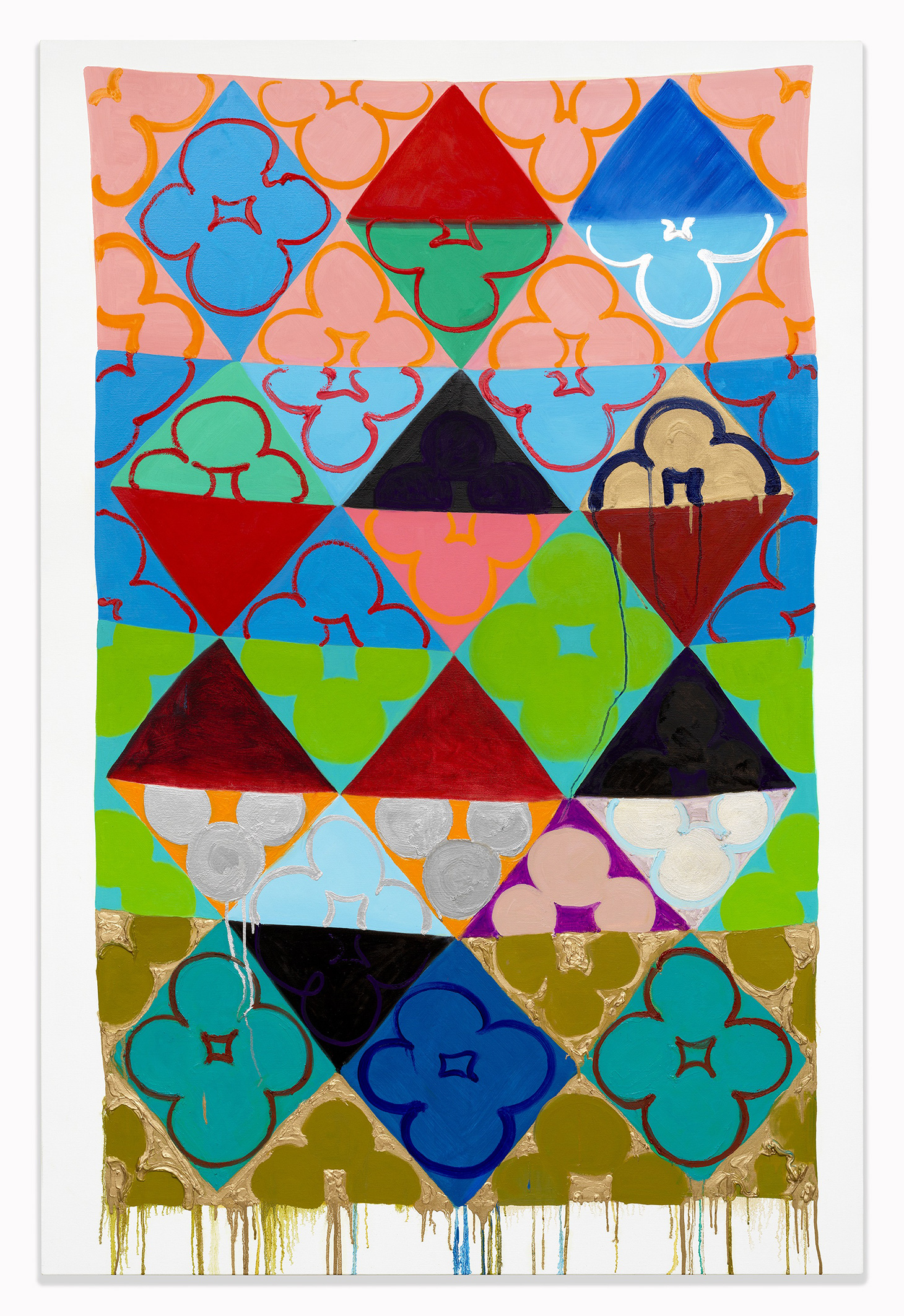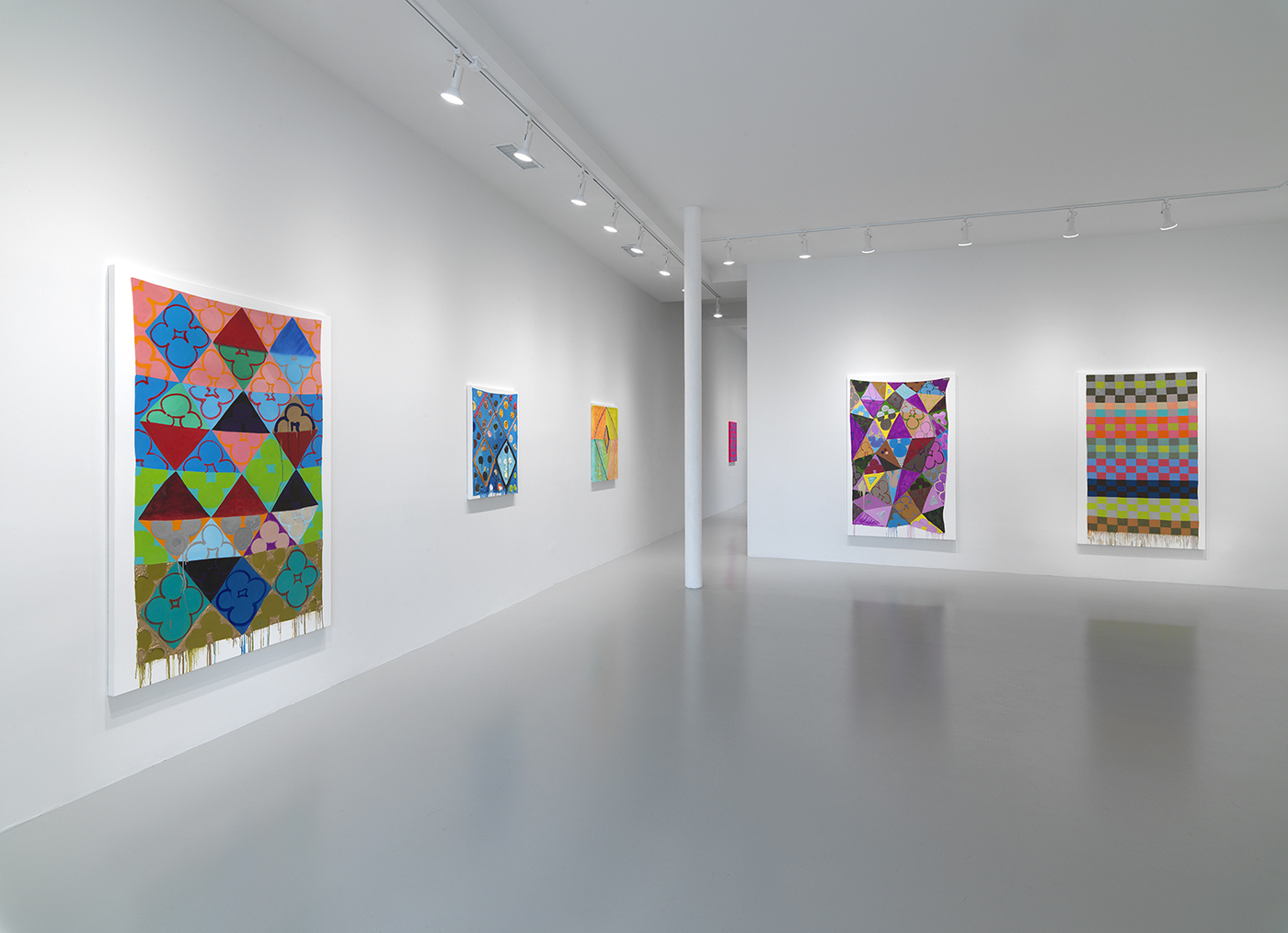by Phillip Barcio
May 17, 2018
Judy Ledgerwood discusses her exhibition Far From the Tree in the context of the 40th anniversary of the Pattern and Decoration movement.
 Judy Ledgerwood, “Sunshine and Shadow” (2018), oil and metallic oil on canvas, 72 x 48 inches (all images courtesy of the artist and Rhona Hoffman Gallery unless otherwise noted)
Judy Ledgerwood, “Sunshine and Shadow” (2018), oil and metallic oil on canvas, 72 x 48 inches (all images courtesy of the artist and Rhona Hoffman Gallery unless otherwise noted)
CHICAGO – It has been forty years since artists Valerie Jaudon and Joyce Kozloff published Art Hysterical Notions of Progress and Culture. They made clear how language had been used to maintain power structures and create arbitrary aesthetic hierarchies in the art world, and their statement became the manifesto of the Pattern and Decoration movement. To commemorate this, I interviewed Chicago-based painter Judy Ledgerwood in her office on the bucolic campus of Northwestern University, where she has taught for 22 years. Ledgerwood has been working with issues like pattern, domesticity, craft, and folk tradition in her studio for years. Raised in a family of quilters, she grew up immersed in an awareness of the deep layers of meaning intrinsic to that and other heritage art forms. Ledgerwood’s recently-opened solo show, Far From the Tree, at Rhona Hoffman Gallery in Chicago, mobilizes pattern as both form and subject matter.
To start our conversation, I asked Ledgerwood to flip through a copy of Art Hysterical Notions of Progress and Culture, and I turned on the recorder.
 Judy Ledgerwood (photo by Richard Cahan)
Judy Ledgerwood (photo by Richard Cahan)
Phillip Barcio: Has this manifesto had relevance to the development of your work?
Judy Ledgerwood: It’s about language. So much of language, like other things that are stylistic, gets lodged in eras. I’m always worried my language is stuck. I use terms like power structure and hierarchy because those were formative concepts for me in school. Looking at this article written by Joyce Kozloff, an artist from a different generation, she’s also talking about hierarchy. Maybe it’s not bound by the age you are, or the time you went to school. Maybe it’s more determined by the issues you work with. She’s working with issues of the decorative, and the power structures of the art world. Maybe hierarchy is a perfectly fine term and I needn’t be so concerned.
PB: Is language essential to your practice?
JL: I feel like the work is a vocabulary, a language I’ve learned that’s taken time to grow for me to feel confident with all the permutations. The basic forms were there, but I have only begun to work out the possibilities, especially the material possibilities. I’ve become more adventurous with the materiality of paint. That came from a real dissatisfaction with surface. It has to do with reproduction and the way so many people experience paintings first on a screen. When you see something on a screen, you might, maybe, get the optical experience, but not the material. I feel so compelled to try to push against that, to absolutely rebel against the screen by creating paintings that you need to see first hand because something materially is happening in terms of scale, or color, or like where paint wraps around the side of the painting so it’s not just on the surface, it’s almost three-dimensional — to just stack up as many things as I possibly can. There’s something about the pervasiveness of the screen that reduces the painting to a commodity.
 Installation view of Judy Ledgerwood at Rhona Hoffman Gallery, Chicago (photo by Tom Van Eynde. Image courtesy the artist and Rhona Hoffman Gallery)
Installation view of Judy Ledgerwood at Rhona Hoffman Gallery, Chicago (photo by Tom Van Eynde. Image courtesy the artist and Rhona Hoffman Gallery)
PB: Are you saying screens diminish what painters do, reducing it to something we can just scroll through?
JL: Yeah. I’ve looked for ways to disrupt that for most of my life as an artist. I want painting to be more, not less.
PB: Your work makes me think about the harmony of patterns, but also the insidious, obsessive nature of repetition. What do patterns mean to you?
JL: I think a lot about the patterns that determine everyday life. The simple pattern of breathing, and your heartbeat, and the sun rising and setting, and how all those small everyday patterns determine the quality of life. I’m interested in drawing attention to the difference in patterns. The difference gives meaning to life. It’s when your heart skips a beat that it’s meaningful.
PB: The Pattern and Decoration movement addressed perceived hierarchies between stylistic choices in art. Is that still a meaningful conversation today?
JL: So many artists are involved with issues relating to craft or design that those boundaries separating high and low art, art and design, or art and craft have all softened. I don’t think that drives the argument so much. But there are other things artists from that generation were working towards that I am still very interested in, like gender and the representation of women in the art world. There’s still a divide between the representation of women and men. The prices generated by the work of women and men are still incredibly unequal. That’s an issue for me. It’s a driving force in the work, or a question in the work. It has to do with content driving the form.
PB: How does content drive form in your new work? For example, the painting “Drunkard’s Path.”
JL: Part of it has to do with the way space is structured. There’s a grid, but it’s a fractured grid. I think about the structure of space as being ideological. The modernist grid represented one idea about space. I think about this fractured grid as being emblematic of our time because it’s nonsensical in many ways. It’s intuitive. It may be balanced, but it’s not at all predictable.
PB: Did you have the title in mind before executing that work.
JL: No. I had in mind this overarching concept of family heritage. I grew up in this culture of quilts. This is what they do in my family. Everybody has their quilt they want to show each other. I’ve been thinking a lot about where I’m from, and the kind of visual culture I’ve taken from my family, and also the visual culture of being in the art world and being familiar with painting. I was thinking about those things in a broader way in terms of culture, and gender. The title is the name of a particular quilt pattern. I was looking at the painting with a friend, and she commented about how there’s no particular focal point. She said, “It’s a little like a Cubist painting, you just pick a point and follow a path through it.” That made me think of Drunkard’s Path.
PB: Would you elaborate on the structure of space as an ideological concept?
JL: For a while I was making paintings based on a grid, but a destabilized grid. Instead of a grid that’s parallel to the edges of the picture plane, I turned the grid on its side in a diamond shape, which is inherently unstable because of the point at the bottom. I could further destabilize it through color combinations. That seemed to make it active enough to reflect a cultural moment. But as we progressed from 2016 forward, I needed to find a pictorial way of organizing the paintings that reflected the chaos of this time. Making a fractured grid seemed more appropriate.
PB: Do the impasto elements in the new work also function as content? For example, the painting “Yoni.”
JL: Making the surfaces impasto in some areas and thin in others was another way of making the paintings structured but also unstable. It’s dynamic; there’s tension. “Yoni” at first glance appears symmetrical, but it’s not. The central form is not in the center. There are contradictions between what you think you see initially and what you actually see. For me that’s important. I work in a very old fashioned way. I block out the painting and all that jazz, which is contrary to the way in which a lot of painters work today. When I get it all blocked out and it’s quote-unquote perfect and everything’s symmetrical, it’s boring. There’s no tension. It’s pretty much exactly like you think it would be. It’s not good. Perfection is boring, because perfection is absolutely predictable.
PB: A karate teacher once told me failures encountered while striving for perfection teach us what’s important to us. If you believe perfection is boring, what are you striving for?
JL: I’m striving for a sense of ease, and a sense of grace, that conveys a sense of humanity. I don’t think perfection conveys humanity. I think it conveys inhumanity. I think in athletics, or some art forms, like dance, that’s a perfectly wonderful thing to strive for. Maybe even for other kinds of painting. But not the kind of painting I do. I think about what my paintings can contribute to culture. Certainly a strong sense of humanity and materiality is important. It’s meaningful because we spend so much time in front of screens and doing things that are completely legislated trying to control what we feel about things.
PB: Feeling seems important to your new work. Are you an expressionist?
JL: Why do you ask that question? Do you think I’m an expressionist?
PB: Your show inspired feelings in me like what I experience when looking at German expressionist paintings. The color relationships, the texture relationships, the way elements interact with each other—it affected me emotionally.
JL: I don’t know, Phillip. It’s been a really hard year. Lots of loss and lots of illness. So if it came out in the work it wouldn’t surprise me. I can’t be very objective about it. I’m so thin-skinned this year because I’ve had so much loss. I wanted to make the best work I’ve ever made, but I just really didn’t give a shit about anything but just making the work. I could back these paintings up with theory if I wanted to. I teach theory. But I really don’t want to do that. I really just wanted to make the work. I want painters to know that’s okay. Not everything has to be so academic. I’m trying to break down all these hierarchies. Theory doesn’t have to come first. Painting is painting. For me this body of work came out of this deep place of feeling at a time when I really just couldn’t think. I needed to paint first, and the thinking will come when I’m ready.
Judy Ledgerwood is on view at Rhona Hoffman Gallery (1711 West Chicago Avenue, Chicago) until May 19.
